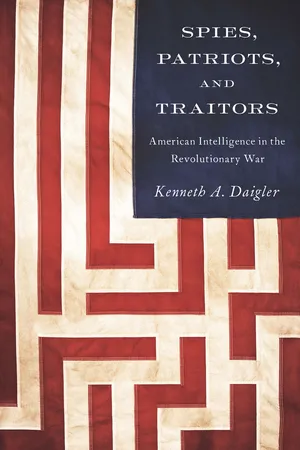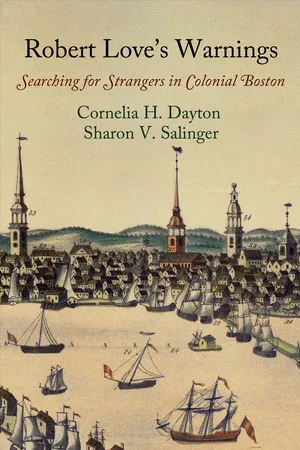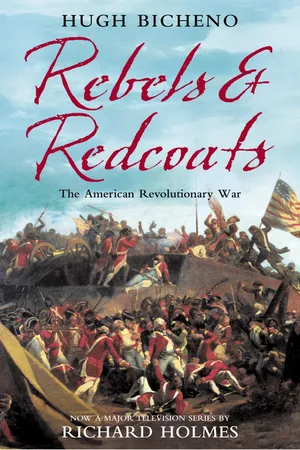History
Boston Massacre
The Boston Massacre was a violent confrontation on March 5, 1770, between British soldiers and a crowd of colonists in Boston, Massachusetts. The incident resulted in the death of five colonists and heightened tensions between the American colonies and Britain, ultimately contributing to the outbreak of the American Revolutionary War.
Written by Perlego with AI-assistance
Related key terms
6 Key excerpts on "Boston Massacre"
- eBook - ePub
Social Studies and Diversity Education
What We Do and Why We Do It
- Elizabeth E. Heilman, Ramona Fruja, Matthew Missias(Authors)
- 2010(Publication Date)
- Routledge(Publisher)
To aid teachers in moving easily through the site, each case follows an identical instructional model consisting of the following four steps: (1) Becoming a Detective, (2) Investigating the Evidence, (3) Searching for Clues, and (4) Cracking the Case. In the sections that follow, we detail the purpose of each step and highlight a case, The Boston Massacre, from the HSI Web site. Like all of the cases we have developed, the Boston Massacre “case” takes a pivotal moment in American history and uses it to introduce students to historical methods and thinking skills while deepening their exposure to American history content. Most historians would agree that the Boston Massacre is a crucial turning point, a moment in which tempers flared between Colonists and the British military whose very presence was a source of controversy. The resulting violence and the deaths of five Colonists may not qualify as a “massacre” in the strictest sense, yet few would dispute its importance as a precursor to the Revolution.Becoming a Detective
In “Becoming a Detective,” students are introduced to the historical scene under investigation. In each case, we intend to capture student interest by succinctly conveying a defining moment in American history. For example, in the Boston Massacre exercise, students are presented first with the outcome of the trial as a way of introducing the case:Students are then presented with a task to help guide their reading and analysis of the sources: At the request of the Daughters of the American Revolution, you have been selected to review the case, to examine a series of key documents and to determine, “Was justice served?”In the fall of 1770, British Captain Thomas Preston and eight of his regulars were tried for the alleged murder of five Boston colonials. At the conclusion of the trial, Captain Preston and six of the eight soldiers were acquitted, with the remaining two soldiers found guilty of manslaughter. These two men were branded on their right thumbs and released.Investigating the Evidence
Students move on to the “Investigating the Evidence” section of the exercise after they have familiarized themselves with the task at hand. Students are provided with hyperlinks to a number of essential digital primary sources that help them begin to piece together a historical narrative, research multiple renderings of an historical account, and assess the credibility of the evidence. To make these cases effective, we sought out documents that relate to one another and that reflect controversy to make the process of discovering historical controversy fairly transparent for teachers and their students. The evidence might include text files, images, audio, or video clips. In the Boston Massacre case, students investigate a variety of documents including competing eyewitness accounts, several artists’ renditions, as well as an excerpt from Joy Hakim’s (2002) textbook series recounting the event. For example, an engraving by Paul Revere in 1770 shows the British firing on an unsuspecting crowd of civilians and he titles the work, The Bloody Massacre Perpetrated in King Street - eBook - ePub
The American Revolution: From the Rejection of the Stamp Act Until the Final Victory
Complete History of the Uprising; Including Key Speeches and Documents of the Epoch: First Charter of Virginia, Mayflower Compact, The Stamp Act, Continental Association, Declaration of Independence
- John Fiske, George Washington, Thomas Jefferson, John Adams, Benjamin Franklin, William Bradford, Patrick Henry(Authors)
- 2019(Publication Date)
- Madison & Adams Press(Publisher)
To their minds, the careless slaughter of six citizens conveyed as much meaning as a St. Bartholomew massacre would have conveyed to the minds of men in a lower stage of political development. It was not strange, therefore, that Samuel Adams and his friends should have been ready to make the Boston Massacre the occasion of a moral lesson to their contemporaries. As far as the poor soldiers were concerned, the most significant fact is that there was no attempt to wreak a paltry vengeance on them. Brought to trial on a charge of murder, after a judicious delay of seven months, they were ably defended by John Adams and Josiah Quincy, and all were acquitted save two, who were convicted of manslaughter, and let off with slight punishment. There were some hotheads who grumbled at the verdict, but the people of Boston generally acquiesced in it, as they showed by immediately choosing John Adams for their representative in the assembly—a fact which Mr. Lecky calls very remarkable. Such an event as the Boston Massacre could not fail for a long time to point a moral among a people so unused to violence and bloodshed. One of the earliest of American engravers, Paul Revere, published a quaint coloured engraving of the scene in King Street, which for a long time was widely circulated, though it has now become very scarce. At the same time, it was decided that the fatal Fifth of March should be solemnly commemorated each year by an oration to be delivered in the Old South Meeting-House; and this custom was kept up until the recognition of American independence in 1783, when the day for the oration was changed to the Fourth of July. Lord North’s ministry Five weeks before the Boston Massacre the Duke of Grafton had resigned, and Lord North had become prime minister of England. The colonies were kept under, and that great friend of arbitrary government, Lord Thurlow, as solicitor-general, became the king’s chief legal adviser - eBook - ePub
Spies, Patriots, and Traitors
American Intelligence in the Revolutionary War
- Kenneth A. Daigler(Author)
- 2014(Publication Date)
- Georgetown University Press(Publisher)
The soldiers’ trial was scheduled for November 20 and moved somewhat quicker, but again the radicals’ objectives were not met, although some minor satisfaction was gained. John Adams did a masterful job of convincing the jury that the soldiers had acted in their own defense under circumstances that legally absolved them of murder charges. On December 5, the jury found five of the soldiers not guilty and two guilty not of murder but manslaughter. These two were subsequently granted clemency, known in this case as the “benefit of clergy,” which involved branding their right thumbs and voided any sentence. With this act, in the legal sense, the Boston Massacre became history.While Samuel Adams had lost the legal battle to establish public blame on the British authorities for the deaths, he was determined to win the battle for the public and subsequently the historic perception of responsibility. Writing in the Boston Gazette , he blandly misrepresented the facts in the case, unfairly criticized the judicial process, and misstated testimony on record.34 Of course, it worked. He further pressed the propaganda campaign by arranging to have the fifth day of March set aside each year as an annual day of mourning, replete with appropriate speeches, memorial ceremonies, and publications. Speaking in retrospect, John Adams stated that the foundation of American independence was laid on the night of March 5, 1770.35With the end of the trials, a political weariness seemed to descend on Boston. The streets quieted down without the presence of British soldiers, and the nonimportation agreement was working. All and all, 1771 was a relatively quiet year but with political maneuvering on both sides. In September, writing in the Boston Gazette , Adams began the first of a series of articles that focused on the growth of colonial freedom within the context of its disputes with British rule. A second set of articles discussed British concepts of individual rights and the separation of powers, further building the political and intellectual argument for greater self-government in the colonies. These articles were reprinted throughout the colonies and created a groundswell of support for the people’s “natural rights” that Parliament was violating.However, 1772 was not going to be quiet. This time the conflict would occur in Rhode Island rather than Massachusetts. Early in the year, the HMS Gaspée , a Royal Navy schooner commanded by Lt. William Dudingston, sailed into Narragansett Bay to assist local royal officials with the smuggling problem. Dudingston, somewhat characteristically of British naval officers, held the colonials in contempt and did little to mask his feelings. Smuggling in Rhode Island was a long-established business and pretty much considered a right. However, Dudingston had a different view. He quickly developed a reputation for harassing all shipping in the bay. On February 17, he seized the Fortune , a sloop owned by Nathanael Greene & Company of Rhode Island and captained by Rufus Greene, a cousin of Nathanael’s. After the boarding party insulted and threatened the captain, Dudingston took the ship and its cargo of rum and sugar to Boston, via Providence, for action by an admiralty court, in direct violation of local colonial laws.36 - eBook - ePub
The Boston Massacre
A Family History
- Serena Zabin(Author)
- 2020(Publication Date)
- Mariner Books(Publisher)
7
A Deadly Riot: March 1770
Lead shot blasted through bodies, tearing through bone, muscle, livers, kidneys, groins. Ripped flesh stuck to clothing. Gore sprinkled the packed snow. A town watchman looked down at part of a blown-off skull as the rest of the body collapsed on his foot. Another, darker man sprawled on the street, blood spurting from his head. In the middle of the street a third body lay still. All three died within moments. Peering out from his doorway, a fourth man felt a musket ball rip through his arm. Another man standing in King Street gasped to his friend, “I am wounded”; a musket ball had gone into his hip and out his side. He lived in agony for ten more days. On March 5, 1770, men bled and died in the snow before the front doors of the Town-House, the home of British royal authority. British soldiers, steel bayonets still fixed to their muskets, stood just a few yards down King Street until Captain Thomas Preston ordered them to march away.In that wide street, ringed with shops, taverns, homes, and offices, Bostonians and soldiers alike were aghast at the carnage. Less than half a mile away stretched the Long Wharf, a finger pointing straight east over the Atlantic toward Europe, from King Street to the king’s palace. Were these deaths the sign that the power of the British Empire had finally come to crush Boston?Paul Revere certainly thought so. As his poem accompanying his engraving of the massacre tells it, British troops reveled in the slaughter:While faithless P[resto]n and his savage Bands,With murd’rous Rancour stretch their bloody Hands;Like fierce Barbarians grinning o’er their Prey,Approve the Carnage, and enjoy the Day.The soldiers are condemned as a group: all bloodthirsty, all equally guilty, and all unnamed. Even their commanding captain, Thomas Preston, is deprived of the dignity of being cited by his full name. - eBook - ePub
Robert Love's Warnings
Searching for Strangers in Colonial Boston
- Cornelia H. Dayton, Sharon V. Salinger(Authors)
- 2014(Publication Date)
- University of Pennsylvania Press(Publisher)
Ten of the women had children with them, for a total of thirty-two persons warned. The late winter and early spring weeks preceding the warnings were the tensest of the occupation. On market days (Thursdays), when no school was held, hundreds of boys joined crowds of adults who gathered outside the shop doors of merchants pegged as violators of the agreement not to import manufactured goods from England. The collective action included the booing and hissing of anyone patronizing the stores and the prominent placement of signs painted with a pointing finger and the word “IMPORTER.” By night, shop windows were smeared with dirt and mud. An incident at John Gray’s ropewalks in the South End on March 2 set the stage for the Boston Massacre. On that Friday morning, Patrick Walker, a private looking to pick up day labor to supplement his army pay, found himself trading escalating insults with some of the workers at this large manufactory. His honor at stake, Walker fetched other soldiers from nearby barracks, and fighting with club and sticks broke out in the ropeyards. Eventually, the soldiers were pushed back to their quarters; by evening, calm prevailed in the neighborhood. But all weekend, rumors swirled that many townspeople were looking forward to “fighting it out with the soldiers on Monday” evening. Indeed, what occurred that evening on King Street as a result of confused and frightened sentries firing into a crowd (leaving five dead and six wounded) was the event that finally persuaded British military leadership that British troops should no longer be housed on peninsular Boston. Within two and a half months, all would be withdrawn to Castle William. 33 Walker was one of three soldiers with featured roles in the Boston Massacre or its lead-up who earned a warning. Not only did these strangers have dependents living in town, but they may have been sought out by Love or his employers because they had proved especially obnoxious to townspeople - eBook - ePub
Rebels and Redcoats
The American Revolutionary War
- Hugh Bicheno, Richard Holmes(Authors)
- 2014(Publication Date)
- William Collins(Publisher)
2 OPENING SHOTS: MASSACHUSETTS I N J OHN A DAMS ’ SUCCESSFUL LEGAL defence of the British soldiers who killed some members of his cousin’s rent-a-mob in the so-called ‘Boston Massacre’ of 5 March 1770, he argued they had been assaulted by a ‘motley rabble of saucy boys, negroes and mulattoes, Irish teagues and outlandish jack tarres’. However, the sort of person who is bold in civil disorders seldom makes a good soldier and one looks in vain for members of the urban rabble described by John Adams among those who stood their ground against redcoat muskets and bayonets in 1775. In what proved to be a transient but myth-defining phenomenon, the Massachusetts conspirators were able to mobilize the moral authority residing in the small land-holders of their colony against a British military governor renowned for his personal decency and political moderation, who was moved to take action against their stockpiling of arms and ammunition only by peremptory orders to do so from London. John Shy styles Lieutenant-General Thomas Gage the ‘Weak Link of Empire’ and blames his vacillating performance first as C-in-C of the British Army in North America (1763–75) and then as governor of Massachusetts (1774–75) with starting the war, ‘under ambiguous circumstances, at the heart of Rebel strength, in an area that could only be a dead end for British strategy, and with a series of humiliating setbacks for His Majesty’s arms’. As to the first three counts, he was trapped into a no win situation by the conspirators and it is difficult to see how he could have acted otherwise. The last charge is the strongest, because he was extremely well informed by a wide network of spies and informers and had been involved in blood-soaked episodes that demonstrated the vulnerability of regular soldiers in broken terrain, as well as the ruinous cost of storming fieldworks
Learn about this page
Index pages curate the most relevant extracts from our library of academic textbooks. They’ve been created using an in-house natural language model (NLM), each adding context and meaning to key research topics.





